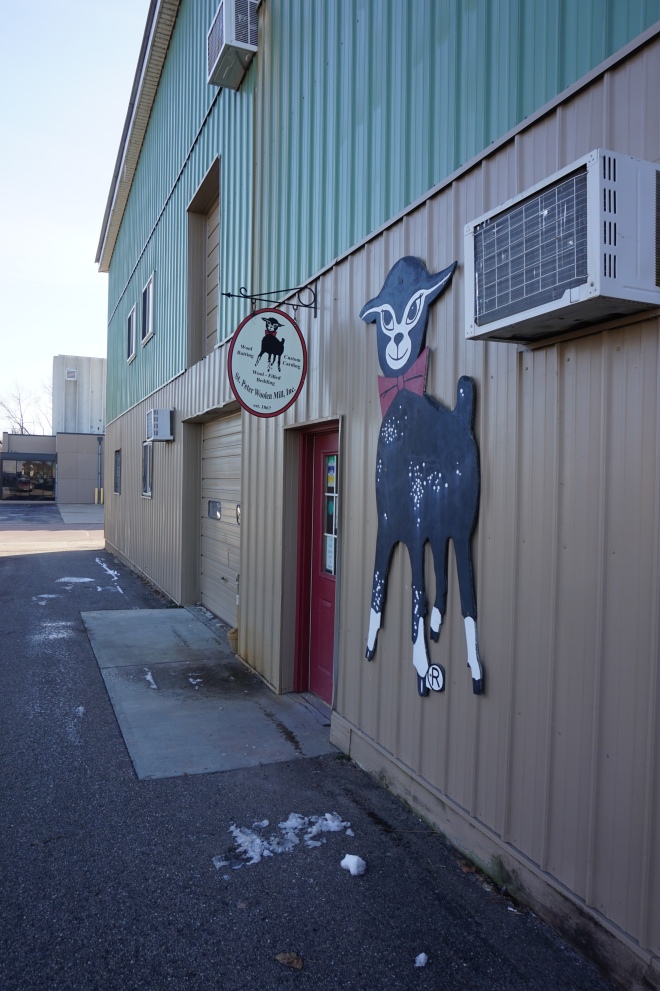Part of the reason I was so suddenly smitten with Grainline Studio’s Tamarack Jacket pattern release was because I had recently attended a tour of local fiber farms through the Natural Fiber Alliance. If you’re in Minnesota or Wisconsin, I highly recommend the fiber tour that NFA puts together each fall. On the tour, I visited a local fiber mill and learned that in addition to spinning yarn, they produce roving, felt, and batting. So when the Tamarack pattern popped up in my Instagram feed I looked at it with new eyes: local wool quilted jacket.
Granted, I have never actually quilted anything before. But I need a mid-level jacket and want to support local farmers and mills as much as possible, so it seemed like the perfect project. I purchased the pattern, picked my fabric (and dyed it with indigo) and contacted the mill to order batting.
And then I waited.
It turns out that the mill I had visited mostly produces yarn and wool goods as a service — meaning they receive fiber from farmers, process it, and send it back — so they don’t have much retail or inventory available, and ultimately I needed to look elsewhere for batting. I really enjoyed doing a bit of research on quilt batting and thought I’d share a roundup of what I found:
Polyester:
When I called and visited local shops, or searched major online stores, I found that synthetic quilt batting dominates the market. I can understand why the low price point and washability would be desirable, but I really try to avoid plastic fibers both because I prefer the feel and benefits of natural fibers (and I wanted the warmth of wool for this jacket) and because synthetics are derived from fossil fuel and polluting the ocean.
Cotton:
Grainline Studio suggests cotton batting as an option for the Tamarack Jacket, and if you’re looking for a lighter weight jacket I’d recommend this Heirloom Cotton Batting from Organic Cotton Plus. It is organically grown and made in the USA, with no chemical additives to offgas in your quilt or jacket.
Wool:
Organic Cotton Plus also offers wool batting, and I kept it in mind as a backup (it is sourced internationally but describes the supply chain and processing with considerable transparency).
When I lived in the Bay Area I loved taking weekend trips north to camp in Marin, Sonoma, and Napa, and once visited Valley Ford Wool Mill. Nestled on a curve of road between rolling hills of pasture, Valley Ford is a working mill with a wonderful Mercantile that sells local wool bedding, yarn, garments, and felted goods. On my visit I bought a pillow, and I considered purchasing their wool batting for this project too.
Digging a little deeper into my local resources, I came across a broader list of Minnesota farms and wool mills, which led me to St. Peter Woolen Mill. This 4th generation family-owned mill is located about an hour from my house and specializes in wool bedding, including pillows, mattress toppers, and duvets, and I was elated to see that they offer quilt batting! Though the wool is not sourced within my immediate radius, I called to ask about their products and learned that they do source entirely from the U.S. (mostly the Western rangeland states).
Always looking for an adventure, I asked if I could pick up an order of quilt batting in person, and learn more about the mill, and mill owner Pat Johnson kindly obliged. The full tour included an interview for an upcoming research project, and provided an in-depth connection to the batting that I purchased. If you’re looking for wool batting or bedding, St. Peter Woolen Mill does an excellent job and sells online as well as wholesales to natural bedding stores around the country. They also offer a unique service: they will reconstitute your existing wool quilt or duvet. If you have a blanket that has gone lumpy or thinned out, St. Peter Woolen Mill can re-process it and send it back to you. The owner told me about family heirloom quilts that have been sent to the Mill multiple times to be re-made, and sent back to the family for continued use. I love this take on mending and making do, and it’s another great reason to invest in quality garments and goods that can last a lifetime (or longer). Batting in hand, I headed back to Minneapolis full of appreciation and excited to make a quilted jacket.

Eager as I was (and am!) to make and wear my Tamarack Jacket, I put the project on pause while making holiday gifts for loved ones and finishing end-of-year work assignments. I’ve changed my mind a few times on the details for this project, and am glad to be taking it slow. Next on the blog, I plan to post a roundup of my One Year One Outfit makes, resources, and processes.



This is such an exciting project and will be much loved I am sure!
LikeLike
Thanks Nicki!
LikeLike